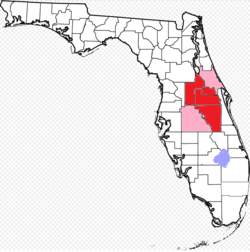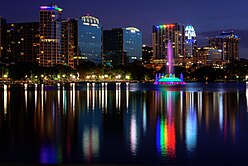
A | B | C | D | E | F | G | H | CH | I | J | K | L | M | N | O | P | Q | R | S | T | U | V | W | X | Y | Z | 0 | 1 | 2 | 3 | 4 | 5 | 6 | 7 | 8 | 9
Greater Orlando | |
|---|---|
| Orlando–Kissimmee–Sanford, Florida Metropolitan Statistical Area | |
From top (left to right): Downtown Orlando skyline at night, Cinderella Castle at the center of Magic Kingdom in Walt Disney World, Orlando International Premium Outlets, Disney Springs at Walt Disney World, main entrance to Universal Studios Florida, and the campus of Rollins College in the community of Winter Park | |
 Greater Orlando with counties with lots of suburbs (in dark red) and counties with few suburbs (in light red) | |
| Coordinates: 28°32′N 81°23′W / 28.54°N 81.38°W | |
| Country | United States |
| State(s) | Florida |
| Largest city | Orlando |
| Other cities | Kissimmee Sanford Saint Cloud Winter Garden Daytona Beach Deltona Winter Park Windermere Apopka Ocoee Casselberry Oviedo Clermont Winter Springs Altamonte Springs Lake Mary Leesburg Bay Lake Lake Buena Vista |
| Area | |
| • Total | 4,011 sq mi (10,390 km2) |
| Highest elevation | Sugarloaf Mountain 312 ft (95 m) |
| Lowest elevation | Sea level 0 ft (0 m) |
| Population (2020) | |
| • Total | 2,673,376[1] |
| • Rank | 22nd in the U.S. |
| GDP | |
| • MSA | $194.5 billion (2022) |
The Orlando metropolitan area, Greater Orlando, Metro Orlando, as well as for U.S. Census purposes as the Orlando–Kissimmee–Sanford, Florida Metropolitan Statistical Area, is a metropolitan area in the central region of the U.S. state of Florida. Its principal cities are Orlando, Kissimmee and Sanford. The U.S. Office of Management and Budget defines it as consisting of the counties of Lake, Orange (including Orlando), Osceola, and Seminole.[3]
According to the 2020 U.S. Census, the population of Greater Orlando is 2,673,376, an increase of nearly 540,000 new residents between 2010 and 2020.
By population, it is the third-largest metropolitan area in Florida, the seventh-largest in the southeastern United States, and the 22nd largest in the United States. The MSA encompasses 4,012 square miles (10,400 km2) of total area (both land and water areas).
Definitions
The Orlando–Kissimmee–Sanford MSA is further listed by the U.S. Office of Management and Budget as part of the Orlando–Lakeland–Deltona, Florida Combined Statistical Area (CSA). This includes the Deltona–Daytona Beach–Ormond Beach (Volusia and Flagler counties), Lakeland-Winter Haven (Polk County), and Wildwood-The Villages (Sumter County) MSAs.[3] As of the 2010 census, the Combined Statistical Area population was 3,447,946, with a 2018 estimate at 4,096,575.[4]
The MSA was first defined in 1950 as the Orlando Standard Metropolitan Area, consisting solely of Orange County. Seminole County was added to the MSA in 1959, Osceola County in 1973, and Lake County in 1992. The name was changed to Orlando–Kissimmee MSA in 2004, and to Orlando–Kissimmee–Sanford MSA in 2009.[5]
Climate and geography
Climate


Like much of the Southern United States, according to the Köppen climate classification, Orlando has a humid subtropical climate (Cfa). The two basic seasons in the Orlando area, are a hot and rainy season, lasting from May until late October (roughly coinciding with the Atlantic hurricane season), and a warm and dry season from November through April.[6] The area's relative low elevation and close proximity to the Tropic of Cancer is what accentuates the humidity climate during the summer months. During these typical humid summer patterns, temperatures typically reach as high as the low 90s °F (32–34 °C), while low temperatures below the low 70s °F (22–24 °C) are pretty rare. The average window for 90 °F (32 °C) temperatures is April 9 to October 14. The area's humidity acts as a buffer, usually preventing actual temperatures from exceeding 100 °F (38 °C), but also pushing the heat index to over 110 °F (43 °C). The city's highest recorded temperature is 103 °F (39 °C), set on September 8, 1921. Strong afternoon thunderstorms are common daily during these months, caused by the air mass from the Gulf of Mexico and the Atlantic Ocean colliding over the region. These storms can be quite powerful, bringing heavy torrential downpours, powerful winds, and even damaging hail.[7]
Humidity cools off during the winter months, resulting in more comfortable temperatures. The monthly daily average temperature in January is 60.6 °F (15.9 °C). Temperatures dip below the freezing mark on an average of only 1.6 nights per year and the lowest recorded temperature is 18 °F (−8 °C), set on December 28, 1894. The annual mean minimum is just above 30 °F (−1 °C) putting Orlando in hardiness zone 10a. There have been some instances of snow accumulation over the years (despite it being rare), such as in January 1977 (which had also reached Miami), along with flurries that were observed in 1989, 2006,[8] and in 2010.[9]
The average annual rainfall in Orlando is 51.45 inches (1,307 mm), a majority of which occurs in the period from June to September. October through May are Orlando's dry season. During this period (especially in its later months), often a wildfire hazard exists. During some years, fires have been severe. In 1998, a strong El Niño caused an unusually wet January and February, followed by drought throughout the spring and early summer, causing a record wildfire season that created numerous air-quality alerts in Orlando and severely affected normal daily life, including the postponement of that year's Pepsi 400 NASCAR race in nearby Daytona Beach.[10]
Like much of Florida, while hurricanes are a risk, the Orlando metro region's inland location gives the region more protection from storms, than compared to southern and coastal regions of the state. The city is located 42 miles (68 km) inland from the Atlantic and 77 miles (124 km) inland from the Gulf of Mexico[a]. Despite its location, the city does see strong hurricanes, as was seen in the 2004 hurricane season, when the Orlando metro region was hit by three hurricanes that year (Hurricane Charley the worst of the three).
- ^ Distance measured from Orlando City Hall to nearest Atlantic coastline, near Oak Hill, Brevard County, and nearest Gulf coastline, near, Pine Island, Hernando County, using Google Earth's Ruler tool.
| Climate data for Orlando (Orlando International Airport), Florida (1991–2020 normals, extremes 1892–present) | |||||||||||||
|---|---|---|---|---|---|---|---|---|---|---|---|---|---|
| Month | Jan | Feb | Mar | Apr | May | Jun | Jul | Aug | Sep | Oct | Nov | Dec | Year |
| Record high °F (°C) | 88 (31) |
90 (32) |
97 (36) |
99 (37) |
102 (39) |
101 (38) |
101 (38) |
101 (38) |
103 (39) |
98 (37) |
93 (34) |
91 (33) |
103 (39) |
| Mean maximum °F (°C) | 83.5 (28.6) |
85.5 (29.7) |
88.4 (31.3) |
91.1 (32.8) |
94.5 (34.7) |
96.1 (35.6) |
96.1 (35.6) |
95.4 (35.2) |
93.8 (34.3) |
91.0 (32.8) |
86.7 (30.4) |
83.7 (28.7) |
97.2 (36.2) |
| Mean daily maximum °F (°C) | 71.8 (22.1) |
74.9 (23.8) |
78.9 (26.1) |
83.6 (28.7) |
88.4 (31.3) |
90.8 (32.7) |
92.0 (33.3) |
91.6 (33.1) |
89.6 (32.0) |
84.7 (29.3) |
78.3 (25.7) |
73.8 (23.2) |
83.2 (28.4) |
| Daily mean °F (°C) | 60.6 (15.9) |
63.6 (17.6) |
67.3 (19.6) |
72.2 (22.3) |
77.3 (25.2) |
81.2 (27.3) |
82.6 (28.1) |
82.6 (28.1) |
81.0 (27.2) |
75.5 (24.2) |
68.2 (20.1) |
63.3 (17.4) |
73.0 (22.7) |
| Mean daily minimum °F (°C) | 49.5 (9.7) |
52.4 (11.3) |
55.8 (13.2) |
60.7 (15.9) |
66.3 (19.1) |
71.6 (22.0) |
73.2 (22.9) |
73.7 (23.2) |
72.4 (22.4) |
66.2 (19.0) |
58.2 (14.6) |
52.9 (11.6) |
62.7 (17.1) |
| Mean minimum °F (°C) | 33.2 (0.7) |
36.5 (2.5) |
41.3 (5.2) |
49.2 (9.6) |
58.2 (14.6) |
67.5 (19.7) |
70.5 (21.4) |
70.7 (21.5) |
67.8 (19.9) |
53.4 (11.9) |
44.4 (6.9) |
37.6 (3.1) |
31.3 (−0.4) |
| Record low °F (°C) | 19 (−7) |
19 (−7) |
25 (−4) |
37 (3) |
47 (8) |
53 (12) |
64 (18) |
63 (17) |
50 (10) |
38 (3) |
28 (−2) |
18 (−8) |
18 (−8) |
| Average precipitation inches (mm) | 2.48 (63) |
2.04 (52) |
3.03 (77) |
2.58 (66) |
4.02 (102) |
8.05 (204) |
7.46 (189) |
7.69 (195) |
6.37 (162) |
3.46 (88) |
1.79 (45) |
2.48 (63) |
51.45 (1,307) |
| Average precipitation days (≥ 0.01 in) | 7.0 | 6.4 | 6.8 | 6.3 | 8.4 | 16.2 | 17.1 | 17.2 | 14.2 | 8.4 | 6.0 | 7.1 | 121.1 |
| Source: NOAA[11][12] | |||||||||||||
| Climate data for Kissimmee, Florida, 1991–2020 normals, extremes 1959–present | |||||||||||||
|---|---|---|---|---|---|---|---|---|---|---|---|---|---|
| Month | Jan | Feb | Mar | Apr | May | Jun | Jul | Aug | Sep | Oct | Nov | Dec | Year |
| Record high °F (°C) | 90 (32) |
90 (32) |
92 (33) |
97 (36) |
100 (38) |
101 (38) |
101 (38) |
103 (39) |
98 (37) |
97 (36) |
92 (33) |
90 (32) |
103 (39) |
| Mean maximum °F (°C) | 82.9 (28.3) |
84.9 (29.4) |
87.4 (30.8) |
90.3 (32.4) |
93.9 (34.4) |
95.5 (35.3) |
95.5 (35.3) |
95.3 (35.2) |
94.0 (34.4) |
91.2 (32.9) |
86.7 (30.4) |
83.6 (28.7) |
96.6 (35.9) |
| Mean daily maximum °F (°C) | 71.8 (22.1) |
74.4 (23.6) |
77.9 (25.5) |
83.0 (28.3) |
87.4 (30.8) |
90.0 (32.2) |
91.5 (33.1) |
91.4 (33.0) |
89.5 (31.9) |
84.6 (29.2) |
78.6 (25.9) |
73.5 (23.1) |
82.8 (28.2) |
| Daily mean °F (°C) | 60.1 (15.6) |
62.6 (17.0) |
66.1 (18.9) |
71.4 (21.9) |
76.6 (24.8) |
80.9 (27.2) |
82.5 (28.1) |
82.7 (28.2) |
81.1 (27.3) |
75.4 (24.1) |
67.9 (19.9) |
62.5 (16.9) |
72.5 (22.5) |
| Mean daily minimum °F (°C) | 48.3 (9.1) |
50.7 (10.4) |
54.4 (12.4) |
59.7 (15.4) |
65.8 (18.8) |
71.8 (22.1) |
73.5 (23.1) |
74.1 (23.4) |
72.8 (22.7) |
66.2 (19.0) |
57.3 (14.1) |
51.5 (10.8) |
62.2 (16.8) |
| Mean minimum °F (°C) | 32.7 (0.4) |
35.4 (1.9) |
40.0 (4.4) |
46.9 (8.3) |
55.8 (13.2) |
66.8 (19.3) |
69.9 (21.1) |
70.6 (21.4) |
67.0 (19.4) |
52.4 (11.3) |
42.9 (6.1) |
36.7 (2.6) |
30.6 (−0.8) |
| Record low °F (°C) | 19 (−7) |
27 (−3) |
25 (−4) |
38 (3) |
41 (5) |
53 (12) |
58 (14) |
60 (16) |
56 (13) |
40 (4) |
29 (−2) |
20 (−7) |
19 (−7) |
| Average precipitation inches (mm) | 2.67 (68) |
2.37 (60) |
3.07 (78) |
2.43 (62) |
4.17 (106) |
9.18 (233) |
7.21 (183) |
8.38 (213) |
5.88 (149) |
3.07 (78) |
1.99 (51) |
2.15 (55) |
52.57 (1,335) |
| Average precipitation days (≥ 0.01 in) | 7.6 | 6.5 | 6.2 | 5.7 | 7.8 | 15.8 | 16.7 | 17.7 | 14.3 | 8.7 | 5.8 | 6.5 | 119.3 |
| Source: NOAA[13][14] | |||||||||||||






